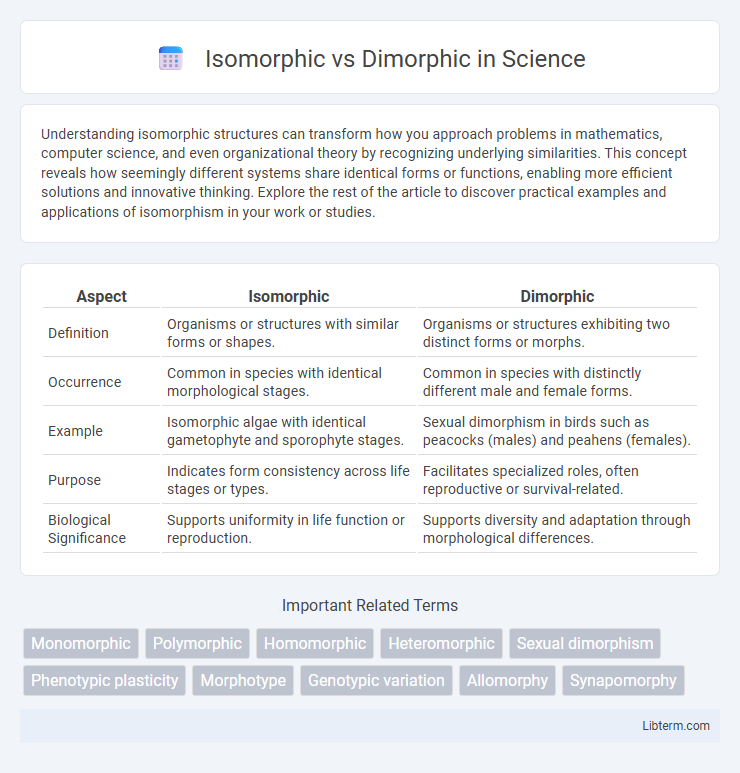Understanding isomorphic structures can transform how you approach problems in mathematics, computer science, and even organizational theory by recognizing underlying similarities. This concept reveals how seemingly different systems share identical forms or functions, enabling more efficient solutions and innovative thinking. Explore the rest of the article to discover practical examples and applications of isomorphism in your work or studies.
Table of Comparison
| Aspect | Isomorphic | Dimorphic |
|---|---|---|
| Definition | Organisms or structures with similar forms or shapes. | Organisms or structures exhibiting two distinct forms or morphs. |
| Occurrence | Common in species with identical morphological stages. | Common in species with distinctly different male and female forms. |
| Example | Isomorphic algae with identical gametophyte and sporophyte stages. | Sexual dimorphism in birds such as peacocks (males) and peahens (females). |
| Purpose | Indicates form consistency across life stages or types. | Facilitates specialized roles, often reproductive or survival-related. |
| Biological Significance | Supports uniformity in life function or reproduction. | Supports diversity and adaptation through morphological differences. |
Understanding Isomorphism and Dimorphism
Isomorphism refers to the structural similarity between two entities, where they share a one-to-one correspondence in components or functions despite being different in appearance or origin. Dimorphism, on the other hand, denotes the existence of two distinct forms within the same species, often related to differences in morphology or behavior, such as sexual dimorphism in animals. Understanding isomorphism involves recognizing analogous patterns across systems, while dimorphism emphasizes distinct dual forms coexisting within a biological or conceptual framework.
Key Differences Between Isomorphic and Dimorphic Systems
Isomorphic systems consist of components that have identical structures or functions, ensuring uniformity and ease of integration across the system. Dimorphic systems feature two distinct forms or types within the same system, often resulting in specialized roles or functions that complement each other. Key differences lie in uniformity versus diversity of components, with isomorphic systems prioritizing consistency and dimorphic systems emphasizing complementary duality.
Biological Contexts: Isomorphism vs. Dimorphism
Isomorphism in biology refers to organisms or structures exhibiting identical or very similar forms throughout their life cycle or across species, such as isomorphic algae with indistinguishable haploid and diploid phases. Dimorphism denotes the presence of two distinct forms within a species, often related to sex differences like sexual dimorphism in birds, where males and females display contrasting plumage. Understanding isomorphic versus dimorphic traits aids in studying evolutionary adaptations, reproductive strategies, and ecological roles in diverse biological systems.
Isomorphism in Plants and Animals
Isomorphism in plants and animals refers to the phenomenon where different life stages or forms of an organism exhibit similar morphological structures despite distinct reproductive modes or life cycles. In plants, isomorphic alternation of generations occurs when the gametophyte and sporophyte stages appear morphologically identical, as seen in some algae species like Ulva. Animal isomorphism is less common but can be observed in certain marine organisms where larval and adult stages share similar body forms, highlighting evolutionary adaptations to their environments.
Dimorphism in Nature: Examples and Significance
Dimorphism in nature refers to the occurrence of two distinct forms or morphs within a species, often related to differences in size, color, or structure between males and females, such as the vibrant plumage of male peacocks versus the more drab females. This biological phenomenon plays a crucial role in evolutionary strategies, influencing mating behaviors, predator avoidance, and resource allocation. Examples of dimorphism extend beyond sexual differences to include seasonal dimorphism in butterflies and environmental-induced dimorphism in amphibians, highlighting its adaptive significance in diverse ecosystems.
Genetic and Evolutionary Perspectives
Isomorphic organisms exhibit identical morphological traits throughout their life cycle, reflecting genetic stability and minimal phenotypic variation in response to environmental pressures. In contrast, dimorphic species display two distinct morphs, often driven by genetic polymorphisms that enhance reproductive success or survival under varying ecological conditions. Evolutionary processes favor dimorphism as a mechanism for niche differentiation and adaptive flexibility, whereas isomorphism may indicate stabilizing selection preserving ancestral traits.
Morphological Adaptations and Their Functions
Isomorphic organisms exhibit similar morphological features across different life stages, enhancing structural consistency and efficient resource use. Dimorphic species display distinct morphological adaptations between forms, often related to reproductive strategies or environmental interactions, such as specialized feeding appendages or coloration patterns. These adaptations in dimorphism support survival by optimizing functionality for varying ecological roles or reproductive success.
Isomorphic and Dimorphic Phenomena in Fungi
Isomorphic phenomena in fungi refer to life cycles where the haploid and diploid stages appear morphologically identical, often seen in many basidiomycetes and some ascomycetes, allowing for seamless transitions during reproduction. Dimorphic fungi, in contrast, exhibit two distinct morphological forms, typically transitioning between yeast and filamentous states in response to environmental conditions, which is a key adaptation for pathogenicity and survival. Understanding these reproductive strategies is critical for studying fungal development, ecology, and pathogenic mechanisms in species like Candida albicans and Histoplasma capsulatum.
Practical Applications in Science and Industry
Isomorphic compounds maintain identical molecular formulas but differ in structure, crucial in pharmaceuticals for drug design to optimize efficacy and reduce side effects. Dimorphic materials exhibit two distinct physical forms or crystal structures, essential in metallurgy and materials science for tailoring mechanical properties such as hardness and ductility. Both concepts enhance innovations in chemical engineering, enabling precise control over substance behavior in manufacturing and product development.
Future Research Directions and Challenges
Future research in isomorphic versus dimorphic studies should prioritize developing advanced molecular techniques to accurately differentiate between the two forms at the genetic and epigenetic levels. Challenges include overcoming the complexity of regulatory pathways influencing the expression of isomorphic and dimorphic traits, as well as integrating multi-omics data for comprehensive phenotype mapping. Emerging computational models and high-throughput sequencing technologies hold promise for elucidating the environmental and evolutionary factors driving isomorphism and dimorphism.
Isomorphic Infographic

 libterm.com
libterm.com